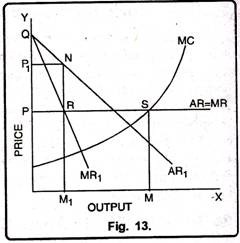Dumping is a special case of price discrimination. It is adopted when producer is selling in two markets, one in which he faces perfect competition and in other he faces the situation of monopoly.
The demand curve for the product will be perfectly elastic for him in the market in which he faces perfect competition, while the demand curve will be sloping downward where he enjoys the position of a monopoly.
This situation can occur when a producer sells his product in his home country in which he has a monopoly and also in the world market which is perfectly competitive. We can show this equilibrium situation with the help of a Fig. 13.
In Fig., the average revenue (AR1) and marginal revenue curve (MR1) are given for the home market. They are sloping downward, since there is monopolistic condition in the home market. Average and marginal revenue for the world market is shown by a horizontal straight line, since perfect competition is assumed in the world market. QRS is the composite (combined) marginal revenue curve for the markets.
ADVERTISEMENTS:
The equilibrium output of the monopolistic firm is determined at the point where MC of the monopolist firm equals composite marginal revenue, i.e., where MC curve of the firm intersects composite (combined) marginal revenue curve, that is, at the point S. Hence, OM is the equilibrium output or the total output that the monopolistic firm will produce.
Instead of selling the whole output either in home market or in the world market, the monopolist will sell a part of it in the home market at higher price OP1 and a part in the world market at the lower price OP, since it gives him maximum returns.
The monopolist is in equilibrium at OM1 level of output, in the home market since at the point R, marginal revenue in home market (MR1) equals marginal cost of the firm. Hence, the monopolist sells OM1 output at OP1 price in home market and M1M output at OP price is the world market.
ADVERTISEMENTS:
The price charged by the monopolist in the home, market is higher than price charged in the world market, i.e. OP1 > OP, where OP1 is price in home market and OP is the price in world market. But the marginal revenue in both the markets (home and world) are equal, i.e., RM1 = SM. Hence, the profits are maximised.
Objectives of Dumping:
The main objectives of dumping are as under:
(a) To dispose off an over-stock casually produced due to wrong judgment of demand.
(b) To develop new trade connections by charging low prices.
ADVERTISEMENTS:
(c) To drive competitors out of the foreign market, whether foreigners or native producers.
(d) To reap economies of large scale production.
(f) To take advantage of differences in demand elasticity.
